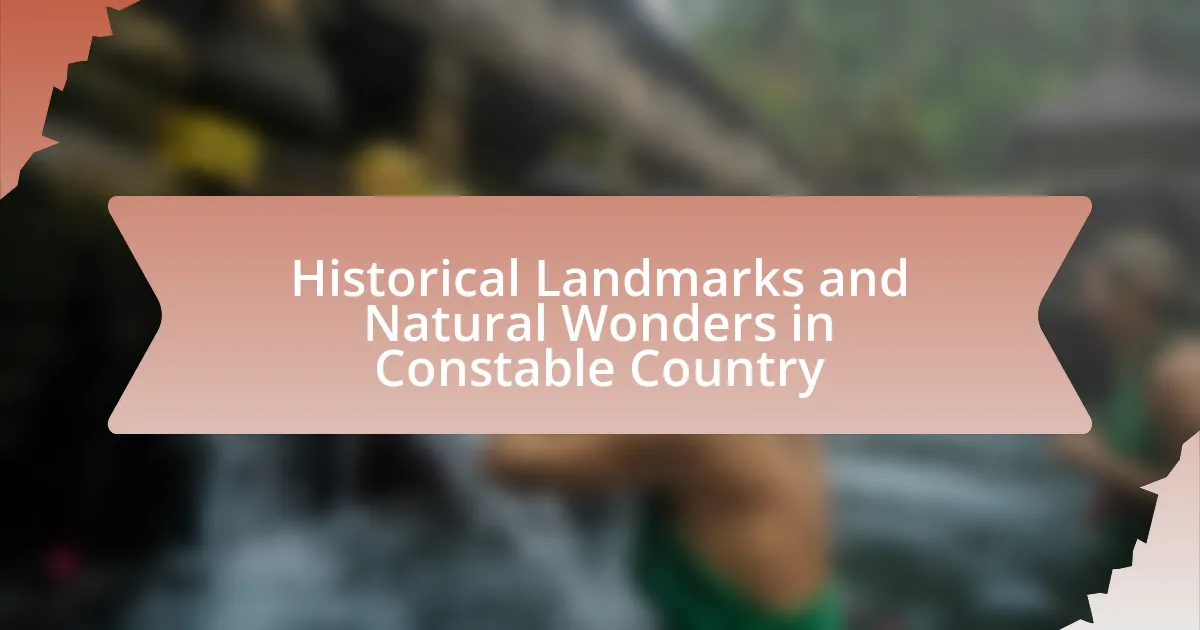Constable Country is renowned for its historical landmarks and natural wonders, prominently featuring sites such as Flatford Mill, Dedham Vale, and the River Stour. Named after the influential painter John Constable, who captured the region’s beauty in his artwork, these locations reflect both cultural significance and environmental value. The article explores the historical importance of Constable, the impact of his paintings on the perception of the area, and the unique ecosystems present. It also discusses conservation efforts, the relationship between landmarks and the natural environment, and how visitors can engage with and support the preservation of this picturesque landscape.

What are the Historical Landmarks and Natural Wonders in Constable Country?
Constable Country features several historical landmarks and natural wonders, including Flatford Mill, Dedham Vale, and the River Stour. Flatford Mill, famously painted by John Constable, is a key historical site that showcases the picturesque landscape of the area. Dedham Vale, designated as an Area of Outstanding Natural Beauty, offers stunning views and rich biodiversity, while the River Stour is known for its scenic beauty and recreational opportunities. These sites collectively highlight the cultural and natural significance of Constable Country, reflecting its historical importance and environmental value.
How did Constable Country get its name?
Constable Country got its name from the famous English painter John Constable, who was born in Suffolk and is known for his landscape paintings that depict the area. His artwork, particularly the scenes of the Dedham Vale, captured the beauty of the countryside, leading to the region being associated with his name. The term “Constable Country” reflects the cultural and historical significance of his work, which has contributed to the area’s identity as a picturesque landscape celebrated in art.
What historical significance does John Constable have in this region?
John Constable holds significant historical importance in Constable Country as he is renowned for his landscape paintings that vividly depict the region’s natural beauty. His works, such as “The Hay Wain” and “Dedham Vale,” not only capture the essence of the English countryside but also contributed to the Romantic movement in art during the early 19th century. Constable’s emphasis on light, atmosphere, and the emotional connection to nature influenced subsequent generations of artists and established Constable Country as a celebrated artistic landscape. His legacy is preserved in various locations throughout the region, including the Constable Museum in East Bergholt, which showcases his life and works, further solidifying his historical significance.
How has Constable’s artwork influenced the perception of this area?
Constable’s artwork has significantly influenced the perception of Constable Country by romanticizing its landscapes and highlighting its natural beauty. His paintings, such as “The Hay Wain” and “Dedham Vale,” showcase the idyllic rural scenery, which has led to an increased appreciation and tourism in the area. The vivid depictions of the English countryside in his works have established Constable Country as a symbol of pastoral tranquility, shaping both local and international views of the region as a quintessential representation of English heritage.
What are the key historical landmarks in Constable Country?
The key historical landmarks in Constable Country include Flatford Mill, Dedham Vale, and the church at East Bergholt. Flatford Mill, famously depicted in John Constable’s paintings, is a picturesque site that showcases the rural landscape of the area. Dedham Vale, designated as an Area of Outstanding Natural Beauty, features rolling hills and scenic views that inspired Constable’s work. The church at East Bergholt, where Constable was baptized, is another significant landmark, reflecting the local heritage and history of the artist’s upbringing. These landmarks collectively represent the cultural and historical significance of Constable Country.
Which landmarks are associated with John Constable’s life and work?
John Constable is associated with several landmarks in Suffolk, England, particularly in the area known as Constable Country. Key landmarks include Flatford Mill, where he painted “The Hay Wain,” and Dedham Vale, which inspired many of his landscapes. Additionally, the village of East Bergholt, where he was born, and Stour Valley, which features prominently in his work, are significant to his life and artistic legacy. These locations are integral to understanding Constable’s connection to the natural beauty that influenced his paintings.
What role did these landmarks play in the local history?
The landmarks in Constable Country served as significant cultural and historical symbols, reflecting the region’s artistic heritage and rural landscape. These sites, such as Flatford Mill and Dedham Vale, inspired renowned painter John Constable, whose works captured the essence of the English countryside and contributed to the Romantic movement in art. The preservation of these landmarks has allowed for the continuation of local traditions and tourism, reinforcing the area’s identity and historical narrative.
What natural wonders can be found in Constable Country?
Constable Country features several natural wonders, including the picturesque landscapes of the Dedham Vale, which inspired the artist John Constable. The area is characterized by rolling hills, lush meadows, and the River Stour, known for its scenic beauty and biodiversity. Additionally, the ancient woodlands and the iconic Flatford Mill contribute to the region’s charm, showcasing the natural beauty that has been preserved and celebrated in art and literature.
How do the landscapes reflect the artistic themes of Constable’s paintings?
The landscapes in Constable’s paintings reflect his artistic themes of nature’s beauty, emotional resonance, and the interplay between light and atmosphere. Constable often depicted rural scenes from his native Suffolk, emphasizing the harmony between humanity and the natural world, which is evident in works like “The Hay Wain.” His use of vibrant colors and dynamic brushwork captures the changing weather and seasons, illustrating his belief that landscapes evoke deep emotional responses. For instance, the depiction of clouds and sunlight in “Cloud Study” showcases his fascination with atmospheric effects, reinforcing the theme of nature’s transient beauty.
What unique ecosystems exist within this region?
Constable Country features unique ecosystems such as wetlands, ancient woodlands, and river valleys. The wetlands, particularly around the River Stour, support diverse flora and fauna, including rare bird species like the bittern. Ancient woodlands, such as those found in the Dedham Vale, are home to a variety of tree species and provide habitats for numerous wildlife, contributing to the region’s biodiversity. The river valleys, characterized by their rich alluvial soils, support lush vegetation and are crucial for maintaining the ecological balance in the area. These ecosystems are vital for conservation efforts and contribute to the overall natural beauty that inspired artists like John Constable.

How do Historical Landmarks and Natural Wonders in Constable Country interact?
Historical landmarks and natural wonders in Constable Country interact by creating a rich cultural and scenic landscape that enhances tourism and education. The presence of historical sites, such as Flatford Mill and Dedham Church, alongside natural features like the River Stour and the surrounding countryside, offers visitors a comprehensive experience that combines history with nature. This interaction is evidenced by the popularity of walking trails that connect these landmarks, allowing visitors to appreciate both the historical significance and the natural beauty of the area, thus fostering a deeper understanding of the region’s heritage and environment.
What is the relationship between historical landmarks and the natural environment?
Historical landmarks are often deeply intertwined with the natural environment, as they frequently reflect the geographical and ecological context in which they were built. For instance, many historical sites are located in areas that offer natural resources, such as water or fertile land, which were essential for the development of communities and economies. In Constable Country, the picturesque landscapes depicted in John Constable’s paintings highlight how the natural environment influenced the architecture and placement of landmarks, such as churches and mills, which were designed to harmonize with their surroundings. This relationship is further evidenced by the preservation efforts that aim to maintain both the historical integrity of landmarks and the ecological health of the landscapes they inhabit, ensuring that the cultural heritage is sustained alongside the natural environment.
How do these landmarks enhance the appreciation of the natural landscape?
Landmarks enhance the appreciation of the natural landscape by providing historical context and cultural significance that enrich the viewer’s experience. For instance, the presence of historical structures, such as churches or mills, juxtaposed against the natural scenery allows visitors to understand the relationship between human activity and the environment. This connection fosters a deeper emotional and intellectual engagement with the landscape, as evidenced by studies showing that visitors to areas with historical landmarks report a greater sense of place and attachment. Additionally, landmarks often serve as focal points that draw attention to the surrounding natural beauty, encouraging exploration and appreciation of the landscape’s features.
What stories do the natural wonders tell about the region’s history?
Natural wonders in Constable Country narrate the geological and cultural evolution of the region, showcasing how natural landscapes have shaped human activity and settlement. For instance, the River Stour, a prominent feature in Constable Country, has historically served as a vital transportation route and influenced local agriculture, as evidenced by the fertile lands along its banks. Additionally, the area’s chalk hills and ancient woodlands reveal insights into prehistoric habitation and land use, with archaeological findings indicating human presence dating back thousands of years. These natural features not only reflect the environmental changes over time but also illustrate the interconnection between the landscape and the livelihoods of the communities that have thrived in Constable Country.
How can visitors experience both historical landmarks and natural wonders?
Visitors can experience both historical landmarks and natural wonders in Constable Country by engaging in guided tours that combine visits to significant sites with exploration of the natural landscape. For instance, the area features historical landmarks such as Flatford Mill and Dedham Vale, which are integral to John Constable’s artwork, alongside natural attractions like the River Stour and scenic walking trails. These tours often highlight the interplay between the region’s artistic heritage and its picturesque scenery, allowing visitors to appreciate the cultural and environmental significance simultaneously.
What are the best routes for exploring these sites?
The best routes for exploring historical landmarks and natural wonders in Constable Country include the A134 and B1061 roads, which provide access to key sites such as Flatford Mill and Dedham Vale. These routes are well-marked and offer scenic views that enhance the experience of visiting the area. The A134 connects major attractions, allowing for easy travel between them, while the B1061 leads through picturesque landscapes that inspired John Constable’s artwork. Additionally, walking trails like the Dedham Vale AONB (Area of Outstanding Natural Beauty) paths offer immersive experiences in nature, showcasing the region’s beauty and historical significance.
What activities can visitors engage in while exploring Constable Country?
Visitors can engage in walking and hiking along scenic trails while exploring Constable Country. The area offers numerous paths that showcase its picturesque landscapes, including the Dedham Vale and the Stour Valley, which inspired the famous painter John Constable. Additionally, visitors can partake in cycling, birdwatching, and photography to capture the region’s natural beauty. Historical landmarks, such as Flatford Mill and the village of East Bergholt, provide opportunities for cultural exploration and learning about the area’s artistic heritage.

What are the conservation efforts for Historical Landmarks and Natural Wonders in Constable Country?
Conservation efforts for historical landmarks and natural wonders in Constable Country include initiatives led by local authorities and heritage organizations aimed at preserving the area’s cultural and natural heritage. The Dedham Vale AONB (Area of Outstanding Natural Beauty) Partnership actively promotes sustainable land management practices to protect the landscape, while the National Trust manages several key sites, ensuring their maintenance and accessibility. Additionally, community engagement programs raise awareness about the importance of these landmarks, fostering local stewardship. These efforts are supported by funding from government grants and charitable donations, which help maintain the integrity of sites like Flatford Mill and the surrounding countryside, recognized for their historical significance and natural beauty.
Why is it important to preserve these sites?
Preserving historical landmarks and natural wonders in Constable Country is crucial for maintaining cultural heritage and biodiversity. These sites serve as tangible connections to the past, allowing current and future generations to understand and appreciate historical events and artistic movements, such as the influence of John Constable’s work on landscape painting. Additionally, these locations support diverse ecosystems, which are vital for environmental health and sustainability. For instance, the preservation of natural habitats contributes to the conservation of species and promotes ecological balance, as evidenced by studies showing that protected areas can enhance biodiversity by up to 30%. Thus, the importance of preserving these sites lies in their role in cultural education and environmental conservation.
What threats do historical landmarks and natural wonders face?
Historical landmarks and natural wonders face threats from climate change, pollution, urban development, and tourism. Climate change leads to rising sea levels and extreme weather events that can erode structures and alter landscapes. Pollution, including air and water contaminants, can degrade the integrity of these sites. Urban development often encroaches on historical areas, leading to loss of context and accessibility. Additionally, uncontrolled tourism can result in physical damage and environmental degradation, as seen in places like the Great Barrier Reef, where increased visitor numbers have led to coral bleaching. These factors collectively jeopardize the preservation and integrity of historical landmarks and natural wonders.
How are local communities involved in conservation efforts?
Local communities are actively involved in conservation efforts by participating in initiatives that protect and restore their natural environments. These communities often engage in activities such as habitat restoration, wildlife monitoring, and sustainable land management practices. For instance, in Constable Country, local residents collaborate with conservation organizations to maintain historical landmarks and natural wonders, ensuring that these sites are preserved for future generations. Evidence of this involvement can be seen in community-led projects that have successfully increased biodiversity and improved ecosystem health, demonstrating the effectiveness of local stewardship in conservation.
What can visitors do to support conservation efforts?
Visitors can support conservation efforts by participating in guided tours that promote awareness of local ecosystems and conservation practices. Engaging in these tours often includes educational components that highlight the importance of preserving historical landmarks and natural wonders. Additionally, visitors can contribute financially by purchasing tickets for conservation programs or donating to local environmental organizations, which directly fund preservation initiatives. According to the National Trust, visitor contributions play a crucial role in maintaining and restoring sites of historical and natural significance, ensuring their protection for future generations.
How can responsible tourism contribute to the preservation of Constable Country?
Responsible tourism can significantly contribute to the preservation of Constable Country by promoting sustainable practices that protect its natural and cultural heritage. This form of tourism encourages visitors to engage in activities that minimize environmental impact, such as using public transport, supporting local businesses, and participating in conservation efforts. For instance, studies show that areas with responsible tourism initiatives experience less degradation of natural resources and improved local economies, which can lead to increased funding for preservation projects. By fostering a sense of stewardship among tourists, responsible tourism helps ensure that the landscapes and historical landmarks of Constable Country are maintained for future generations.
What are some best practices for visiting these sites sustainably?
To visit historical landmarks and natural wonders in Constable Country sustainably, prioritize minimizing your environmental impact. First, use public transportation or carpool to reduce carbon emissions. Additionally, adhere to designated paths and guidelines to protect local flora and fauna, as studies show that off-trail hiking can lead to soil erosion and habitat destruction. Carry reusable water bottles and containers to avoid single-use plastics, which contribute to pollution. Lastly, support local businesses and services to promote the regional economy while ensuring that tourism benefits the community. These practices collectively contribute to the preservation of Constable Country’s unique heritage and environment.


